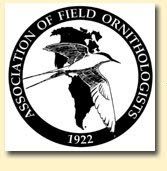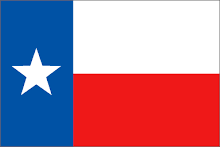Or all around me at the moment, at least concerning 2 members.
The
Sulidae family contains the gannets and boobies.
Sula species are large seabirds with long wings, wedge-shaped tailes and stout, conical bills.

Red-footed Boobies(
Sula sula)coming in from sea as the sun goes down. RFBO's are quite numerous on Tern. They are the smallest of the Sula spp. of the Tropical Pacific.
Boobies plunge from the air to capture their prey. Boobies are frequent victims of frigatebird(
Fregata spp)kleptoparasitism. Its not uncommon here to see a Great Frigatebird(
Fregata minor) harass a booby, while flying, to where the bird drops its food and the frigatebird captures it for its own meal. Sometimes doing so before the fish hits the water. But often it will pluck it from the ocean surface.
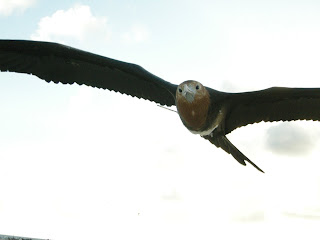 Great Frigatebird
Great Frigatebird, some people think and speak poorly of the frigatebirds, with terms such as "mean", "bullies". I really don't think our species has any room to judge another species. We received the bigger brain and opposable thumb, and look what we've done with it. I tend to see the frigatebird as opportunistic.
Some boobies are ground-nesters, the Red-footed's nest in trees and shrubs. RFBO's are a pantropical species. Only casually seen on Florida's Dry Tortugas and CA coast.
Other boobies have a more restricted range.
The largest booby is the Masked Booby(
Sula dactylatra). There are a number of MABO's on Tern Island. These guys seem quite giant compared to the slighter Red-footed. While on the ground, if walking, they waddle around somewhat penguin like. Seabirds(sans the smallest guys, like Noddies) just don't take off like small songbirds. Therein lies the almost always blowing ocean wind. But even with a 15 knot wind, the MABO if hanging out on the ground which is very common, need alot of running room to get airbourne. It run kicking both legs at the same time.
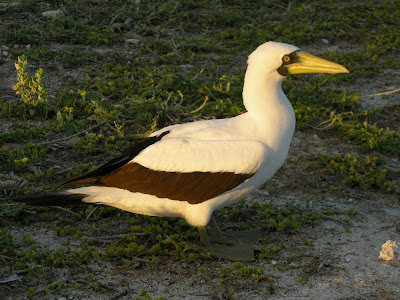
Masked Booby
All of these guys are great, because rarely is one afforded some close association with seabirds. They are usually dots seen off of a boat, or the lucky blow-over to a coast after a storm. BUT these next two are quite cool. There is only one of each spp. that is ever seen on island. The first pretty much a resident among the MABO's in the colony, the second a fly-in/fly-out guy it seems. Two beautiful "needle's in a haystack...."
For along time the Masked Booby had a subspecies that was found in tropical Pacific waters off of South and Central America up to Baja California's in Mexico. But it has recently been split from the Masked Booby.
The Nazca Booby(
Sula granti), pronounced "NASCAR" if you are from Boston. One immature landed on a ship off northern Baja California and rode to San Diego in 2001. There are some iffy records of Nazca Booby off southern and central CA. Nazca is similar to Masked in a plumages; there are some very subtle shape differences it seems. But now note the distinctively orange bill and more orange iris...
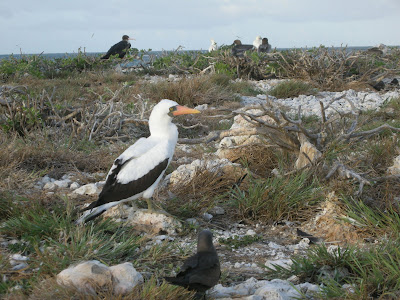
Nazca Booby
There is also a Brown Booby. A very handsome bird, very numerous out at La Perouse Pinnacle. I suppose they covet that high, cliff-like, vantage point. But one comes around to tern on occasion. I had seen it 3 times so far. I guess I've been here a month now. During my Entrapment Walk this morning I saw it for a 4th time. We had a brief, but satisfying photo shoot.

Brown Booby,left Red-footed Booby,right
So there is the illustrated lesson of some members of Family
Sulidae. A great group of
Aves, particularly the RFBO juveniles out here. They are extremely curious, and once they have the ability to fly they are alot of fun. I've had them hover, eye-level with me, while walking or riding a bike. One hung out for around 45 minutes on the backrest of the go-cart seat, while I was working some landscaping. It even rode with me for a little while. I took it slow, but he never got off. He seemed to briefly think about it, and had to regain some balance at first but he kept his perch. That was RFBO '2025. He's a good kid.
I actually get a 2-day weekend. We are taking Saturday off instead of Monday(Columbus Day, or Discoverer's Day, whatever they are now calling it). Could devote a whole essay regarding the topic of that holiday.
I hope everyone is well.
Go UH 'bows. #15 in the country.
Sigh, and go BU Bears too.

I have to go as well.
Peace.




